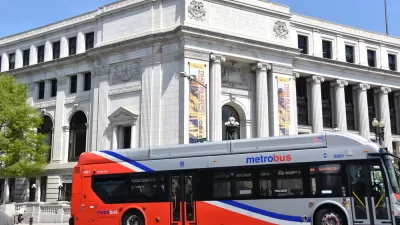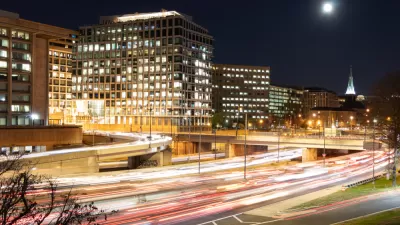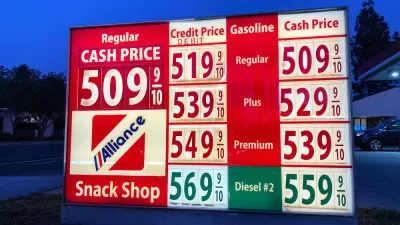With transit systems still far below historic levels, and congestion not budging, the worst effects of an automobile dependent nation fall on the environment and low-income households.

One of the big questions of the early pandemic was about the future of transportation systems: Would transit riders ever find a bus or train commute safe again? Would congestion disappear forever or come back worse than ever?
During the height of stay-at-home orders—weeks of empty streets and reports of urban dwellers fleeing forever for suburban and rural locations—it might have seemed like a future without congestion was possible.
Now, two-plus years after the beginning of the pandemic, transit ridership is still down from pre-pandemic levels and congestion is still the order of the day for most American commuters. The choices of hundreds of millions of commuters have far-reaching consequences, social, economic, and environmental, and researchers are only beginning to account for the effects of the change.
An article by Jaclene Begley, Leah Brooks, Brian J. McCabe, Jenny Schuetz, and Stan Veuger for the Brookings Institution explores the Washington, D.C. area as a case study of post-pandemic commute patterns, citing data and findings reported in the “State of the Capital Region” report recently published by the Center for Washington Area Studies and authored by the same group as the article.
Among the article’s, and the report’s, findings are that decreases job centralization is contributing to a decline of transit ridership in the region. Job centralization is a central to the performance of a “hub and spoke” transportation system. “Metrorail’s hub-and-spoke system was designed to carry workers from their suburban homes to that downtown core, as well as to supporting businesses like coffeeshops, restaurants, and bars. Tourists relied on Metrorail to access centrally located hotels, museums, and entertainment venues,” according to the article.
The report raises the point that transit ridership was declining before the arrival of Covid-19 to the United States. While the report acknowledges that the shift reflects consumer trends and preferences, there are numerous reasons why commuters should choose alternative modes:
Moving commuters in individual cars (especially sole-occupant vehicles) requires much more physical space compared to shared buses or trains. Smaller shares of transit riders mean more traffic congestion and longer commute times for everyone. The transportation sector is one of the largest contributors to greenhouse gas emissions and localized air pollution; more drivers and fewer transit riders leads to worse air quality and more negative health outcomes in the region. Owning and maintaining a car is expensive; these costs are especially onerous for low- and moderate-income households. And finally, not everyone is legally or physically able to drive; children, people with disabilities, and older adults are among the groups who are most reliant on non-car transportation.
Finally, the article notes the equity issues raised by underinvesting in public transit: the consequences of car-centric planning, automobile dependency, and poor public transit fall hardest on low-income households.
FULL STORY: Greater Washington’s commuters continue to choose gridlock

Planetizen Federal Action Tracker
A weekly monitor of how Trump’s orders and actions are impacting planners and planning in America.

Congressman Proposes Bill to Rename DC Metro “Trump Train”
The Make Autorail Great Again Act would withhold federal funding to the system until the Washington Metropolitan Area Transit Authority (WMATA), rebrands as the Washington Metropolitan Authority for Greater Access (WMAGA).

The Simple Legislative Tool Transforming Vacant Downtowns
In California, Michigan and Georgia, an easy win is bringing dollars — and delight — back to city centers.

The States Losing Rural Delivery Rooms at an Alarming Pace
In some states, as few as 9% of rural hospitals still deliver babies. As a result, rising pre-term births, no adequate pre-term care and "harrowing" close calls are a growing reality.

The Small South Asian Republic Going all in on EVs
Thanks to one simple policy change less than five years ago, 65% of new cars in this Himalayan country are now electric.

DC Backpedals on Bike Lane Protection, Swaps Barriers for Paint
Citing aesthetic concerns, the city is removing the concrete barriers and flexposts that once separated Arizona Avenue cyclists from motor vehicles.
Urban Design for Planners 1: Software Tools
This six-course series explores essential urban design concepts using open source software and equips planners with the tools they need to participate fully in the urban design process.
Planning for Universal Design
Learn the tools for implementing Universal Design in planning regulations.
Smith Gee Studio
City of Charlotte
City of Camden Redevelopment Agency
City of Astoria
Transportation Research & Education Center (TREC) at Portland State University
US High Speed Rail Association
City of Camden Redevelopment Agency
Municipality of Princeton (NJ)





























